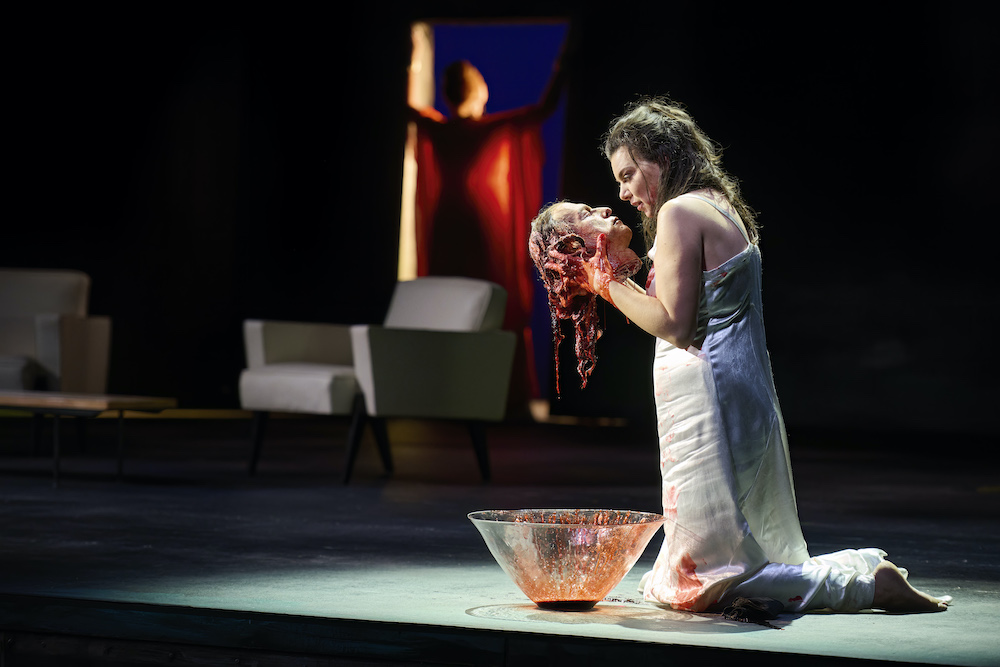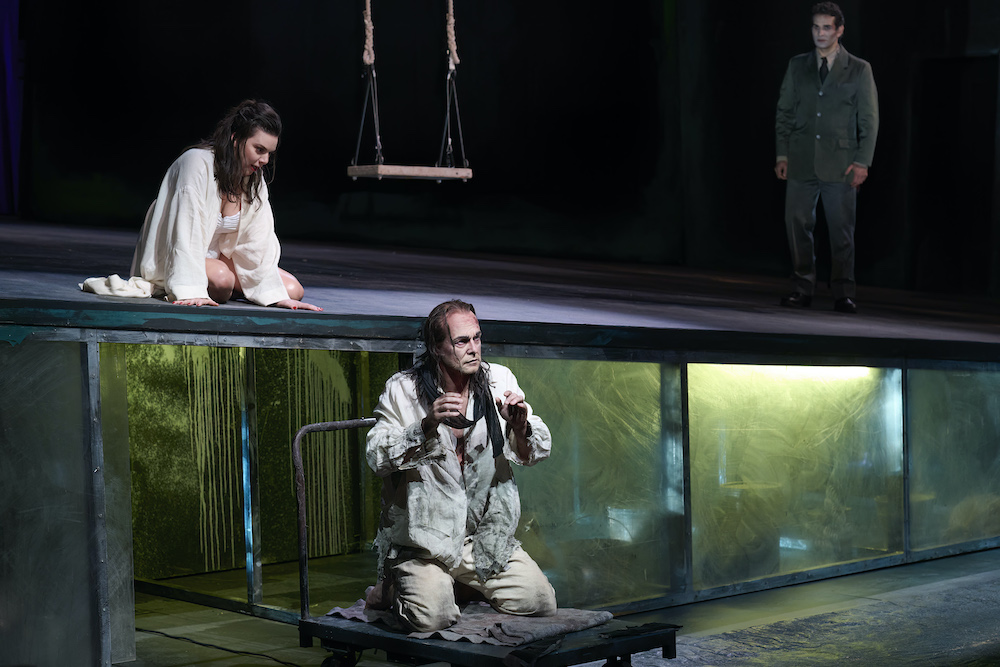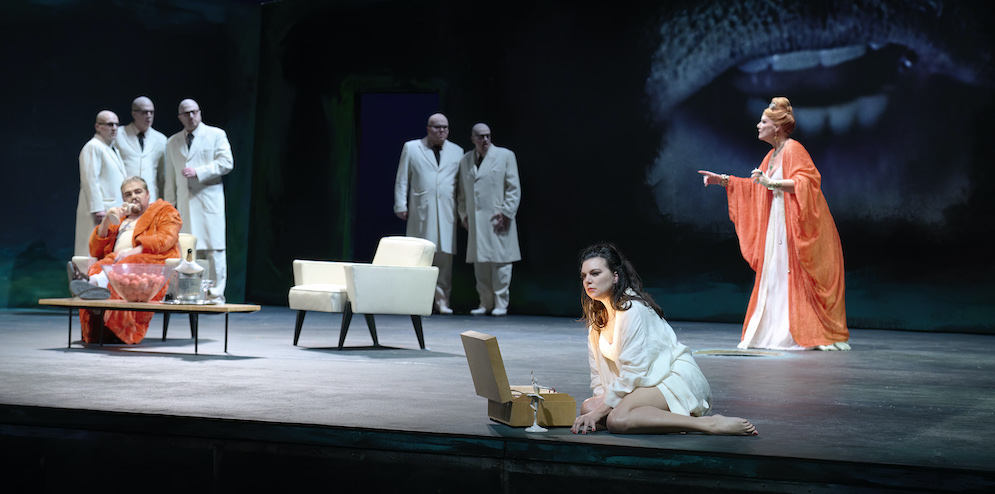“Oscar Wilde’s Salome was not worthy of you…it has a nauseous and sickly atmosphere about it…Wilde’s Salome, and all those who surround her, except that poor creature [John the Baptist], are unwholesome, unclean, hysterical, or alcoholic beings, stinking of sophisticated and perfumed corruption. —in vain do you transfigure your subject, increase its vigor a hundredfold, and envelop it in a Shakespearean atmosphere —in vain do you ascribe moving accents to your Salome: you transcend your subject, but you can’t make one forget it.”
That was French author and musicologist Romain Rolland writing to his friend Richard Strauss after seeing the 1907 Paris premiere of the composer’s opera. Rolland’s reaction, a mixture of admiration and distaste, was typical of the emotions the work had provoked since its sensational world premiere in Dresden 18 months earlier. Sometimes, the distaste won out. Salome premiered in New York in 1907, too, but there was only one performance. A cabal of wealthy influencers including banker J. Pierpoint Morgan pressured the Met to withdraw it, offended by what a New York critic described as “the moral stench exhaled by the decadent and pestiferous work.”
More than a century on, as the February 3 opening of the Canadian Opera Company’s current revival demonstrates, the opera still packs a hefty emotional punch. Director Atom Egoyan first mounted this production in Toronto in 1996, then for co-producers Vancouver Opera and Houston Grand Opera the following year. He returned to it again at the COC’s Four Seasons Centre in 2002 and 2013, and each time has tweaked and rethought to sharpen the presentation. No question, this latest iteration is the keenest yet in its exploration of the psychology of the title character. Should we embrace her in sympathy, or reject her in revulsion? Are her actions the result of nature or nurture? Is she the hapless child victim of terrible circumstances or a depraved teen perpetrator of horrific sex crimes? As in his movies, Egoyan is uncompromising but subtle in probing his characters’ vulnerabilities and prodding their raw nerves. The result here, which will also play a part in Egoyan’s next movie, which he starts shooting next month, is audibly and visually visceral.

The COC’s 2022/23 season is mainly one of revivals, but to date the familiar productions have also been revitalized by the strength of their casting. That’s eminently the case with this Salome, in which soprano Ambur Braid gives an extraordinary performance in the title role. She limns the arc of her harrowing journey in fine dramatic and vocal form—from bored fascination with Jochanaan (John the Baptist), through sexual attraction and obsession, to an unhinged determination to assert her power and mutilate the object of her passion. One of the great challenges of the role, which Braid meets resoundingly, is to portray Salome’s disintegration dramatically while cutting through the huge orchestral backing with the lyricism Strauss always affords his sopranos no matter what their circumstances. She’s matched in this respect by the John of German baritone Michael Kupfer-Radecky in his company debut. Some singers flaunt the prophet’s moral rectitude on their vocal sleeves by stressing his music’s stentorian declamation. Kupfer-Radecky, though, takes a more lyrical approach and makes the character more sympathetic without lessening his authority. Though he never looks at her, this John seems genuinely troubled by Salome rather than dismissing her advances out of hand.
Back when this production was new, tenor Michael Schade was making an international career as a lyric tenor and an accomplished Mozartian. A quarter century on, he’s taking on much heavier German repertoire, in this revival singing Salome’s lascivious stepfather, Herod. It’s an impressive role debut, vividly acted and articulately sung. As befits the vacillating character, Herod’s lines are choppy and rhythmically complex. Schade copes with them with assurance and enough tenor ping to give them vocal substance. Finnish soprano Karita Mattila, herself a much-lauded Salome earlier in her career, returns to the COC as the odious Herodias; predictably, her impact on stage is greater than the sum of the relatively few lines Strauss assigns her role.
Though Salome is a shortish one-acter, it fields a large cast of 17 named roles, albeit a couple of these are very brief and a number are melded in larger groupings. So, there are: five white-suited, bald-pated Jews, whose intricate, argumentative number was seamlessly sewn together by tenors Owen McCausland, Michael Colvin, Jacques Arsenault and Adam Luther and bass-baritone Giles Tomkins; two threatening soldiers in the well-matched bass of Scott Conner and bass-baritone Vartan Gabrielian; and two Nazarenes, whose more elegiac response to the fractious Jews was nicely sung by bass Robert Pomakov and baritone Jorell Williams. Tenor Frédéric Antoun is a rich-voiced but increasingly desperate Narraboth, in love with Salome, and, despite the warnings and sexual ministrations of the Page (mezzo Carolyn Sproule), driven to kill himself as his fantasies appear to reach an orgasmic conclusion.
Narraboth, though, is just collateral damage; the opera is all about the relationship between John and Salome, and the turning point in the piece comes when he decisively rejects her insistent advances with a curse. Little of what we see comes from the story’s biblical sources, but rather from the perfervid imagination of Oscar Wilde. After seeing Wilde’s play, Strauss essentially set the German translation verbatim, albeit discarding a good third of the text. Egoyan’s staging, with the original sets by Derek McLane and costumes by Catherine Zuber, moves even further from the biblical setting of Herod’s Machaerus hilltop palace in modern day Jordan. His staging plays out in a spa or sanitorium with characters in vaguely modern dress. There is a sparse, sterile look to the place, and the pronounced rake of the stage suggests that things are out of kilter. There are some rich colors on the set walls, as well as startling bright flashes—the ruby lips in one of the projections, the garish orange robes of Herod and Herodias—but for the most part the action unfolds with recurrent images of eyes, voyeurism and surveillance in a gloomy nighttime palette (Michael Whitfield’s original lighting design here revived by Davida Tkach).

As before, Egoyan makes liberal use of filmed projections throughout the show (Philip Barker is the projections designer) and one of the most effective innovations in this revival is the finer co-ordination of film and shadow play in the opera’s iconic dance sequence. Strauss wrote the dance music after he wrote the rest of the opera, and the sequence stands out as much musically as it does dramatically. The composer apparently never intended it to be a sexy strip tease, once writing that it should be “as serious and measured as possible, and thoroughly decent, as if it was being done on a prayer mat;” the music, however, tends to militate against such a decorous approach. Egoyan uses the sequence to tell Salome’s back story, starting from the filmed image of an innocent little girl on a swing in a garden with a white picket fence and ending with the shadow image of the teen dancing and being threatened by looming male figures. Shadow designer and dancer Clea Minaker has enhanced the original choreography of Serge Bennathan to bring greater sensuality to the extended dance segment, which itself flows more naturally out of the film.
I leave to last-but-not-least the elephant in the hall—the 90-plus members of a COC Orchestra greatly enhanced by extra players. At the point he wrote Salome, only his third opera, Strauss had already written most of the large-scale symphonic pieces that are repertoire standards today. He applied that experience to produce one of opera’s noisiest and most discordant scores, deeply textured harmonically and often providing the rich coloring beneath relatively austere vocal lines. The COC musicians handled it all with sonorous panache and to exciting effect. It’s tough to keep voices and orchestra in balance in this piece, but COC Music Director Johannes Debus largely succeeded and certainly deserves all credit for masterminding a detailed, well-paced soundscape in which the tension didn’t let up for one minute. This Salome may be disturbing on the mind and ear, but it is music-theatre at its best. You may be attracted, you may be repelled, but you will not remain indifferent.
Related content ⬇
Opera Canada depends on the generous contributions of its supporters to bring readers outstanding, in-depth coverage of opera in Canada and beyond. Please consider subscribing or donating today.
CANADIAN OPERA COMPANY
FEB 3 to 24 2023
R STRAUSS SALOME
CAST AND CREATIVE TEAMS
Conductor Johannes Debus
Assistant Conductor Derek Bate
Director Atom Egoyan
Assistant Director Marilyn Gronsdal
Set Designer Derek McLane
Costume Designer Catherine Zuber
Original Lighting Designer Michael Whitfield
Revival Lighting Designer Davida Tkach
Projections Designer Phillip Barker
Choreographer Serge Bennathan
Revival Choreographer Julia Aplin
Shadow Designer Clea Minaker
Intimacy Coordinator Siobhan Richardson
Stage Manager Jenifer Kowal
Salome Ambur Braid
Jochanaan Michael Kupfer-Radecky
Herod Michael Schade
Herodias Karita Mattila
Narraboth Frédéric Antoun
The Page Carolyn Sproule
First Jew Owen McCausland
Second Jew Michael Colvin
Third Jew Jacques Arsenault
Fourth Jew Adam Luther
Fifth Jew Giles Tomkins
First Nazarene Robert Pomakov
Second Nazarene Jorell Williams
First Soldier Vartan Gabrielian
Second Soldier Scott Conner
Cappadocian Alex Halliday
An Attendant Alex Hetherington
With the COC Orchestra
THE SOCIAL BUZZ
BEAUTIFUL DAUGHTER & PROUD MAMA ♥️🎶😍🎶💋
— Karita Mattila (@MattilaKarita) February 5, 2023
READY FOR TODAY’S MATINEE 💃#Salome #Herodias @MsAmburBraid😘 @CanadianOpera 🇨🇦🎶 pic.twitter.com/W6KhnAtRBU
Thank you @CanadianOpera #COCFigaro. What a truly epic performance! A perfect early Valentine's Day treat for you and a loved one.
— Thirty Four Flavours (@30fourflavours) January 28, 2023
I took my high school writing workshop teacher. He was instrumental in inspiring my post secondary studies. Cheers @michaelmcmorro2, till the spring! pic.twitter.com/3Wdn84Dmyi











